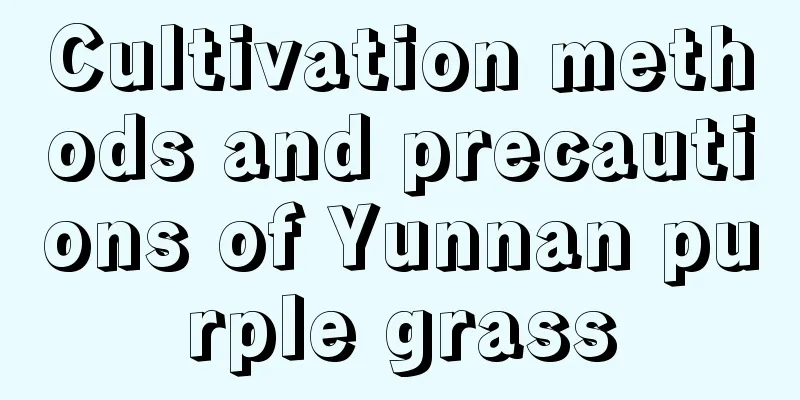Cultivation methods and precautions of Yunnan purple grass

1. Maintenance methods1. Temperature: It does not have high requirements for the temperature of the maintenance environment. The minimum temperature cannot be lower than ten degrees, and the maximum temperature cannot exceed thirty-five degrees. During this period, it can grow normally. 2. Watering: Water it thoroughly when it is dry, especially in the dry season. Water it fully each time. If it is rainy season, drainage needs to be done well to prevent the roots from being soaked in water for a long time and causing root rot. Its roots are very sensitive, and if they are kept in water for a long time, they are prone to root rot. 3. Fertilization: Before planting, 7,000 kg of animal manure is needed per hectare of soil. This is to ensure that it has sufficient nutrients in the early stages of growth. When the plant reaches the growth period, it needs to be fertilized once a month. The fertilizer should be a comprehensive and nutritious compound fertilizer. 4. Light: It can receive full-day sunlight. If it cannot receive full-day sunlight, at least six hours of light per day must be guaranteed. 2. Breeding techniques1. Reproduction: It can be propagated by sowing, and the sowing time is divided into autumn sowing and spring sowing. The time for autumn sowing is November. Spread the seeds evenly on the soil, cover with three centimeters thick soil, and then press it slightly. Seedlings will emerge in about ten days. If the seeds are sown in spring, they must be treated with low temperatures so that the embryos can develop more maturely. If dry seeds are sown, the plants may not germinate that year. After the seeds are prepared, sow the seeds evenly in shallow trenches with a row spacing of 15 cm and cover them with soil. 2. Filling the seedlings: During the seedling stage of the plants, it is necessary to check for gaps and fill in the sparse areas with seedlings. Filling the seedlings should be done on rainy days or in the evening, and watering is required after filling. 3. Problem Diagnosis1. Pests: The pests of Yunnan lithospermum include ants, cutworms, weevils, etc. They can be killed manually or by using poison bait. 2. Pathology: It is susceptible to leaf spot disease. After infection, irregular spots will form on the leaves of the plant. If found, the diseased plants need to be pulled out and destroyed in time, and then sprayed with Bordeaux liquid for treatment. IV. Other issues1. Edibility: It is not edible, but can be used as medicine. 2. Is it suitable for family breeding? It is not suitable for family breeding. Because it has certain medicinal properties, if it is accidentally consumed, it will have certain side effects, so it is not recommended for home breeding. |
<<: Cultivation methods and precautions of Atractylodes lancea
>>: Cultivation methods and precautions of winter vegetables
Recommend
Causes and solutions for yellowing gardenia leaves
Gardenia is loved by people for its beauty and fr...
How to place flowers and plants at home, super practical!
Entrance, window It is suitable for placing water...
The reason why the stem of the money tree shriveled, can the stem wrinkles be restored?
1. Too much watering The money tree is very droug...
How to fertilize Osmanthus fragrans
1. Time of fertilization: Osmanthus fragrans like...
What to do if the leaves of potted roses turn yellow
1. Rehydrate in time Reason: If the leaves of the...
How much is the market price of Bletilla striata
1. Market Price Under normal circumstances, the p...
What fertilizer is best for Chlorophytum comosum
1. Fertilizer If we want to add fertilizer to it,...
How to prune fragrant wood
Fragrant wood pruning time The pruning of fragran...
What flowers can be watered with fermented milk? The correct way to water flowers
Fermented milk watering effect Fermented milk can...
What to do if the leaves of Crinum citrifolia turn yellow
Reasons why the leaves of Crinum orchid turn yell...
How to grow groundroot in autumn
1. Breeding methods 1. Watering: It likes moistur...
How to care for water bamboo in winter
Is water bamboo afraid of freezing? Water bamboo ...
How often should I water the four-season camellia?
How often should I water the four-season camellia...
How to grow lucky bamboo fast
Pot soil selection The soil for the Chinese lucky...
When is the best time to prune roses?
Overview of Rose The rose blooms for a long time,...









